I felt like a fraud at first, but I returned to the deer meadow in 2021 by train and bike. Last year's prohibitions on the use of public transport for non-essential journeys meant completing the entire 52 mile round trip by bicycle. I can now step off the train and cycle to the nature reserve, but I still get 8 miles of cycling. I am drawn to the meadow in early June because an explosion of wildflowers attracts Roe deer from surrounding land to feed, raise young and establish territory for the rutting season.
I've struck lucky with a tolerant older buck this summer (see below). At first, I thought he was the same buck from 2019 and 2020, but they are probably just related. He was a little nervous on the first encounter. The buck got up, ate as many buttercups as he could and moved to a different spot nearby. It's almost as if was hedging his bets. My presence didn't frighten him, but the deer stocked up on energy in case I turned out to be one of the unfortunate recent disruptive human visitors, whose noisy activity prevented deer from grazing in their meadow.
Male roe deer are very territorial in summer, so with the right approach, it's relatively easy to spend time photographing them. Roe deer would obviously prefer not to have my company at all, but they will continue with their activity if they can see me at all times and I don't try to hide. The paradox at this particular site is that while humans disturb the roe every day, if it wasn't for human visitors, the roe wouldn't have learned to tolerate quiet observers nearby with a camera. However, the presence of humans and dogs reduces the chance of observing roe interacting with one another. I am therefore mostly limited to watching single deer. If only I could persuade the council to seal off the entire reserve every June!

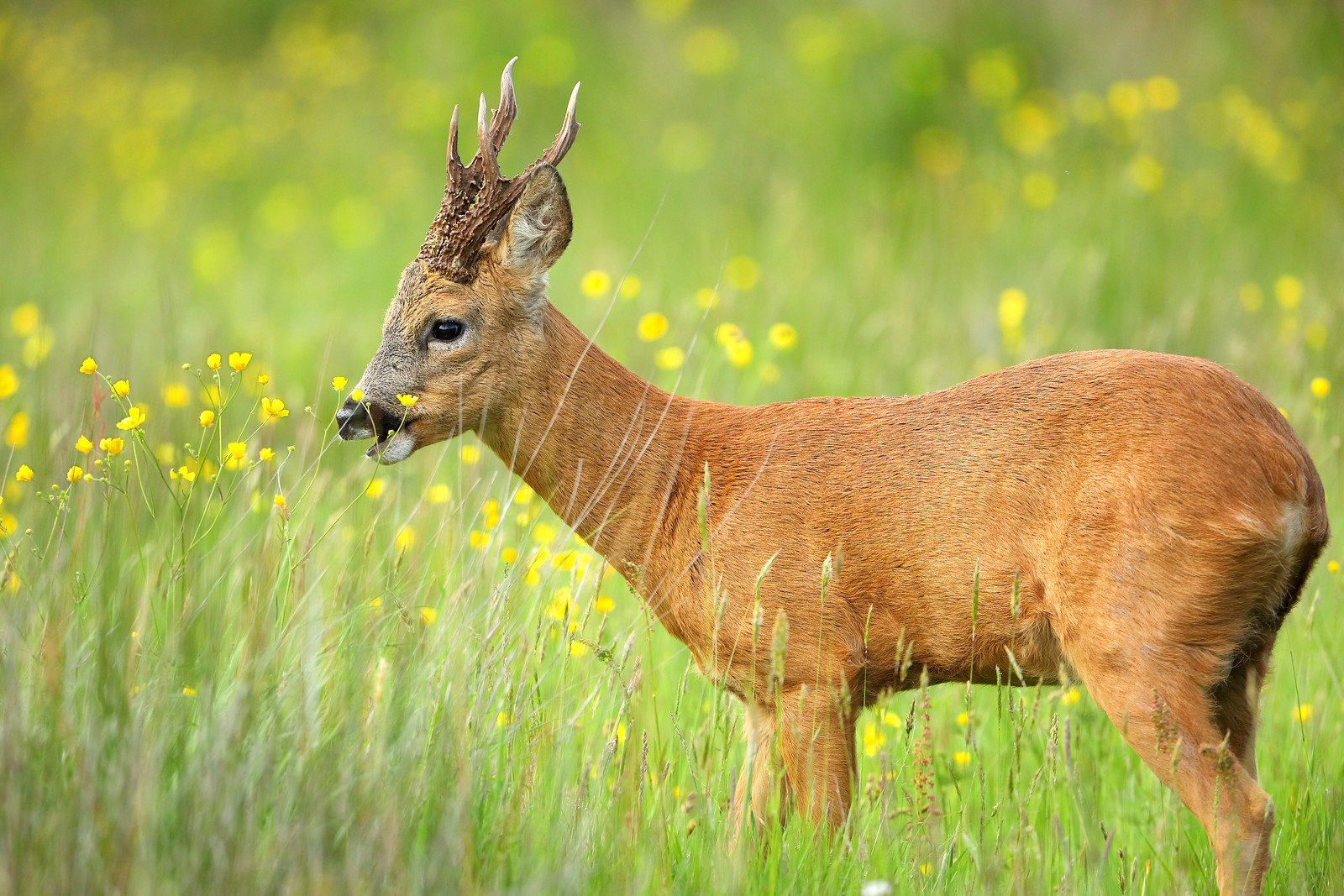
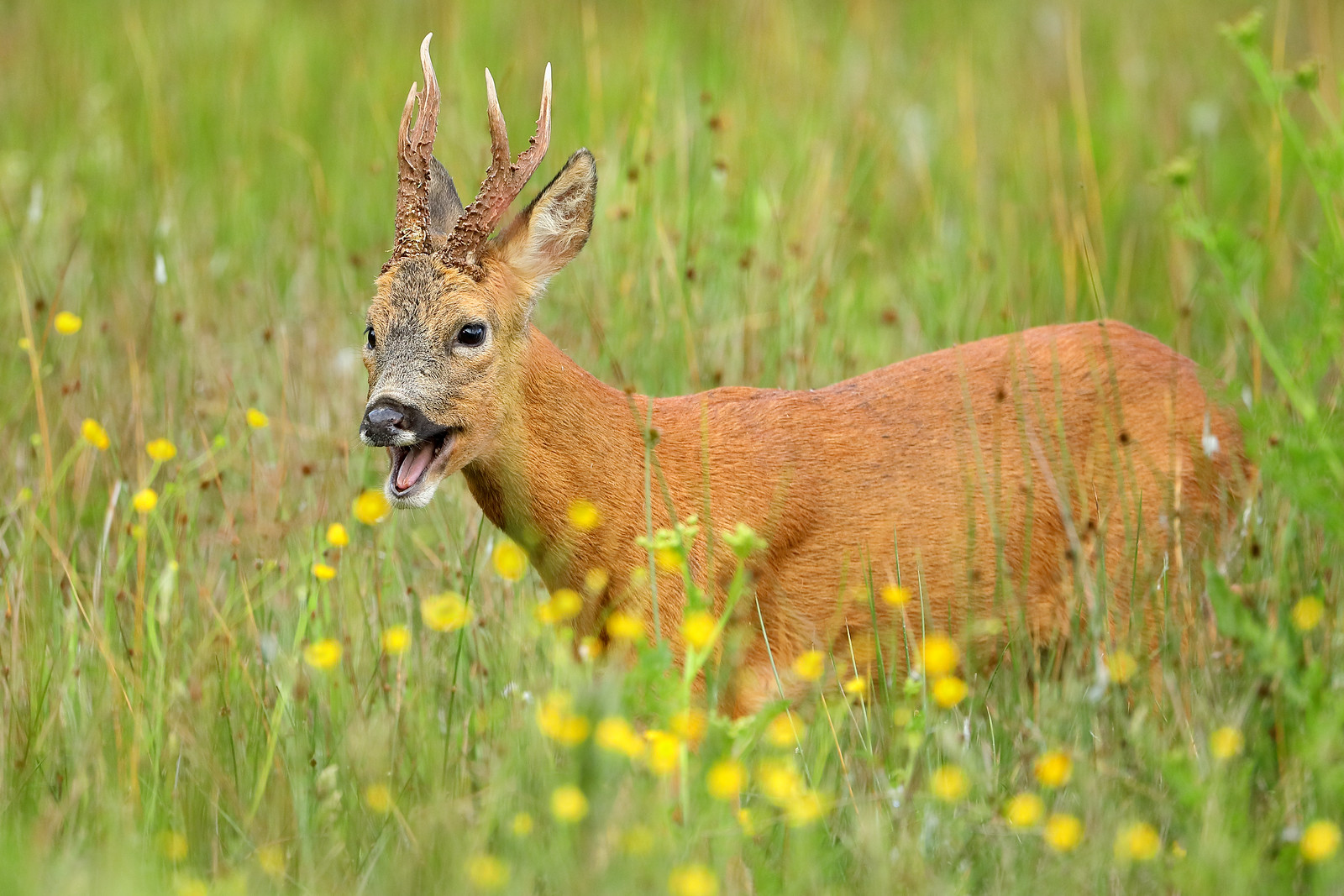
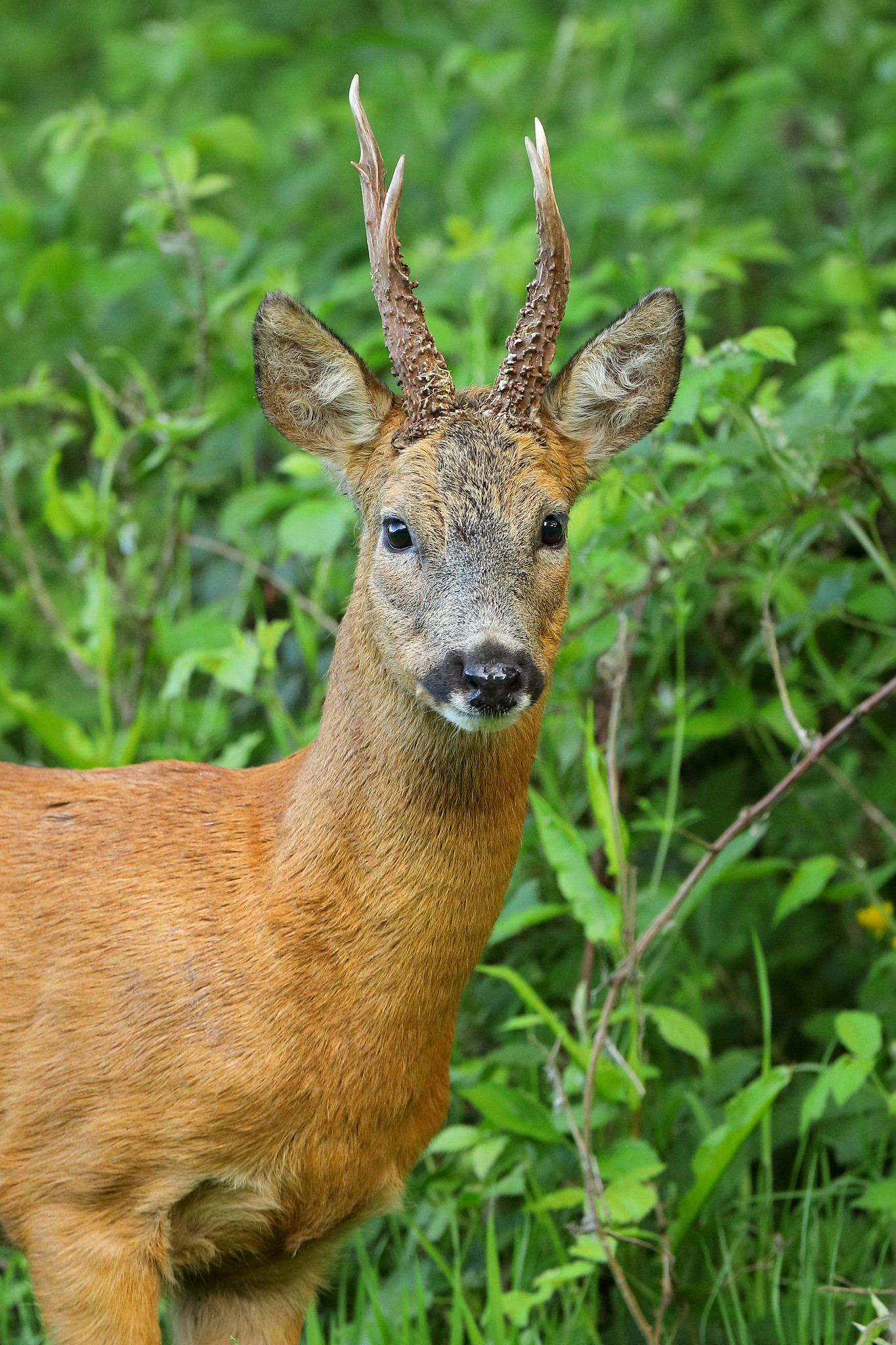


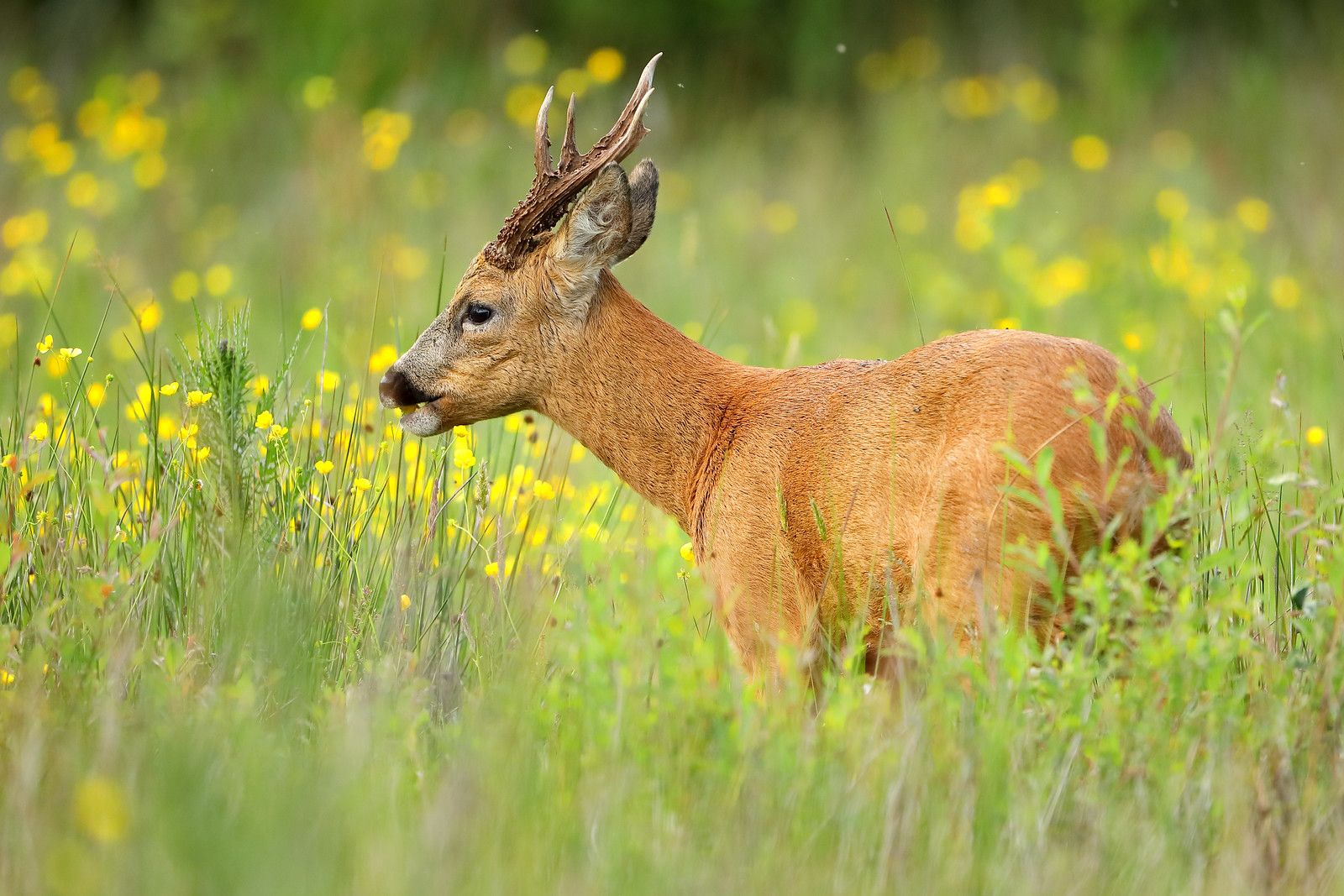
Nature can be a cruel place and this female Roe deer must raise her baby despite being blind in her right eye. In this case, it looks like the condition is caused by a corneal disease. She must consume enough nutrients from the rich meadow to sustain herself and produce milk, which is in regular demand. The meadow looks idyllic in early June and the weather is usually very good, but the reality is that deer have to survive here in all conditions. We humans are fortunate to have evolved large brains and developed advanced technological infrastructure to shield us from the brutal indifference of nature.
Although humans share a common ancestor with Roe deer, we are so different. We live on the same planet, yet humans are so alienated from nature that encounters such as this invite us into a different world. When we humans exit the cocoon of our sedentary, indoor lives and step out into wild places, we are fishes out of water. A wildlife photographer, with knowledge of how to calm roe deer is almost like an astronaut. Extraterrestrial life may or may not exist elsewhere in the universe, but intelligent life is probably extremely rare. I often wonder how theoretical aliens would react if they encountered humans. Would they treat us the way humans often treat other animals? All too often, the alien invader mindset affects how humans view nature. A recent BBC video ostensibly showed a woman 'rescuing' her dogs from a bear. It did not occur to the BBC that the bear might have been defending its young from the dogs and that human invasion of natural habitats is forcing wildlife into urban areas.
It was unusual to see a mother and her baby together in daytime, as their extra level of wariness normally keeps them away from public areas. The Kids, as they are known, usually spend daytime hidden in long grass, while the doe feeds. Until early June, the UK endured low temperatures, heavy rainfall and strong winds. Coronavirus restrictions left many people unable to attend large gatherings or go on holiday, so the nature reserve became a site for illegal raves, firework displays, camping and the dumping of rubbish.
It would be dishonest to pretend that we can just carry on with business-as-usual, all the while shielding wildlife inside reservations. It's becoming ever more urgent that in order to keep the planet habitable, vast areas of land need to be returned to the wild. While individual action can make a difference, history shows that only collective action through organised movements can shatter the status quo.
As an environmental injustice, there's a similarity between the settler-colonialist mindset and the theft of natural habitats from its native life. When a group takes land and resources at the expense of another, the relationship between indigenous people and their environment is broken. In the global south we see all surface life forms evicted from areas of land and their life support systems destroyed to grow produce demanded by consumers in the global north. This happens most often on the level of nation-states and corporations, but also on a more personal level, like the human supremacists who recently disrupted the lives of wild animals here just to satisfy their temporary urges. Someone just decided "I want fire a shotgun every 30 seconds for six hours" or "I want to have a rave and invite hundreds of people". That meant birds and other animals couldn't gather food for their young until the people stopped. Worse still, the possibility of a vast construction project could one day see the entire nature reserve destroyed.
Perhaps the daytime appearance of the mother and her baby was a sign of nature catching up on lost time whenever an opportunity arose. It certainly helped that the temperature reached 27°C in a sudden transition to summer — a good 20 degrees warmer than on my visit to a nearby forest in late May, when I spent 2 hours shivering under a tree in torrential rain.

I was upset to see that this familiar face had lost his right eye, most probably in an accident. Bucks can injure each other with their antlers during fights. It's also possible that his eye was damaged by a sharp object, such as a branch. Human eyes can detect three colours — red, green and blue, but roe deer see the world in shades of green and blue. They aren't so good at identifying still subjects, but will easily spot movement. Wild animals are genetically hardwired to be stoic. The buck adapted to his new disability. I found him picking out buttercups and reaching up to eat leaves from low-hanging branches. I first spotted him in 2016, when he was about two years old. Whenever I see him, his grey-white face reminds me of the moon. He rarely strays from one particular field and will be the father to many of the roe seen in the meadow.
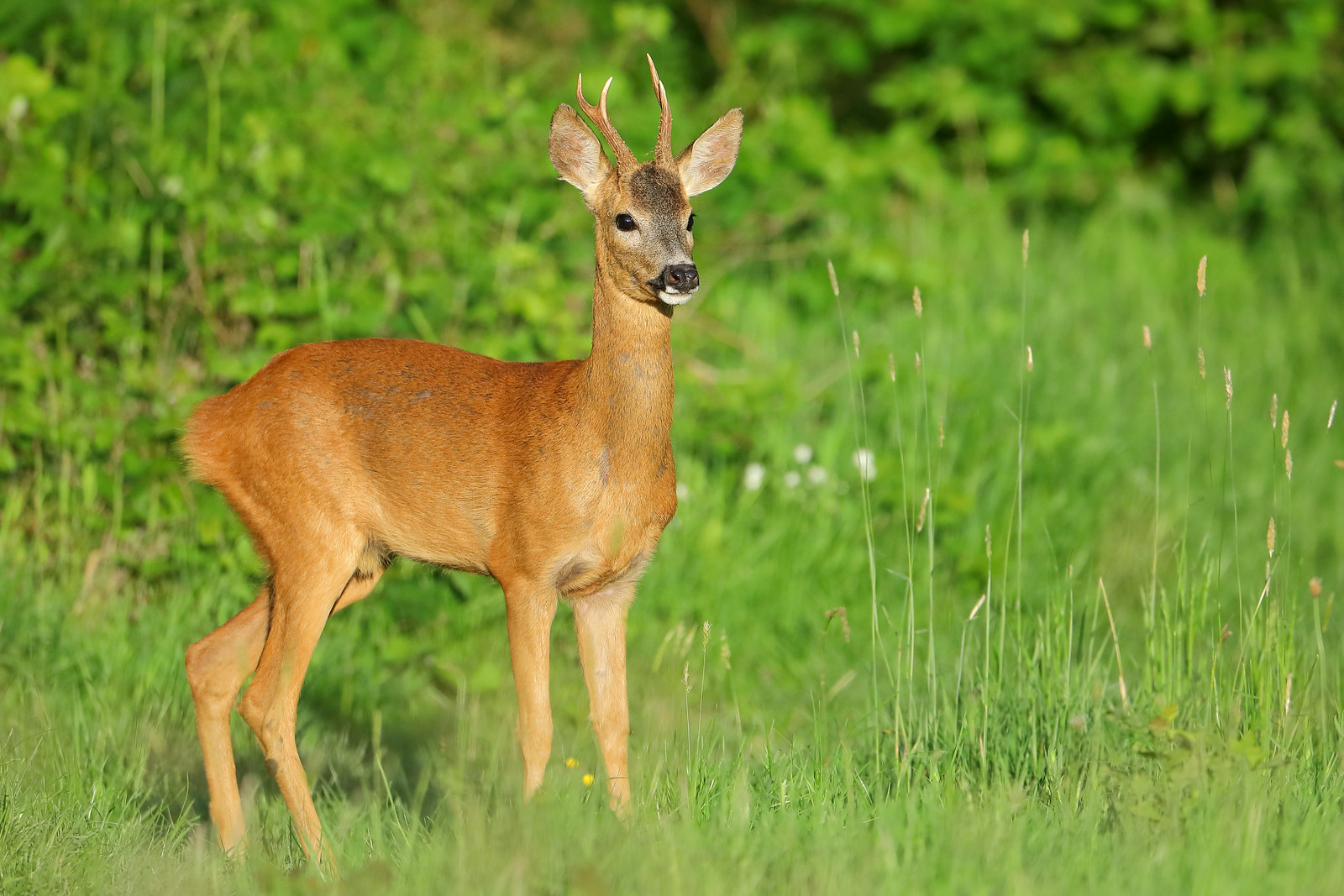
This exotic-looking supermodel is the new kid on the block. I saw a female version of him dart across a field in 2019. They both have chiseled features, great facial symmetry and a gazelle-like appearance. They are probably related. There was nothing I could do about his state of alarm (see raised fur on posterior) and he didn't stick around for long. He appeared again on a sunny evening around the periphery of a field used to graze horses, but it's likely that older, more dominant bucks will chase him off.

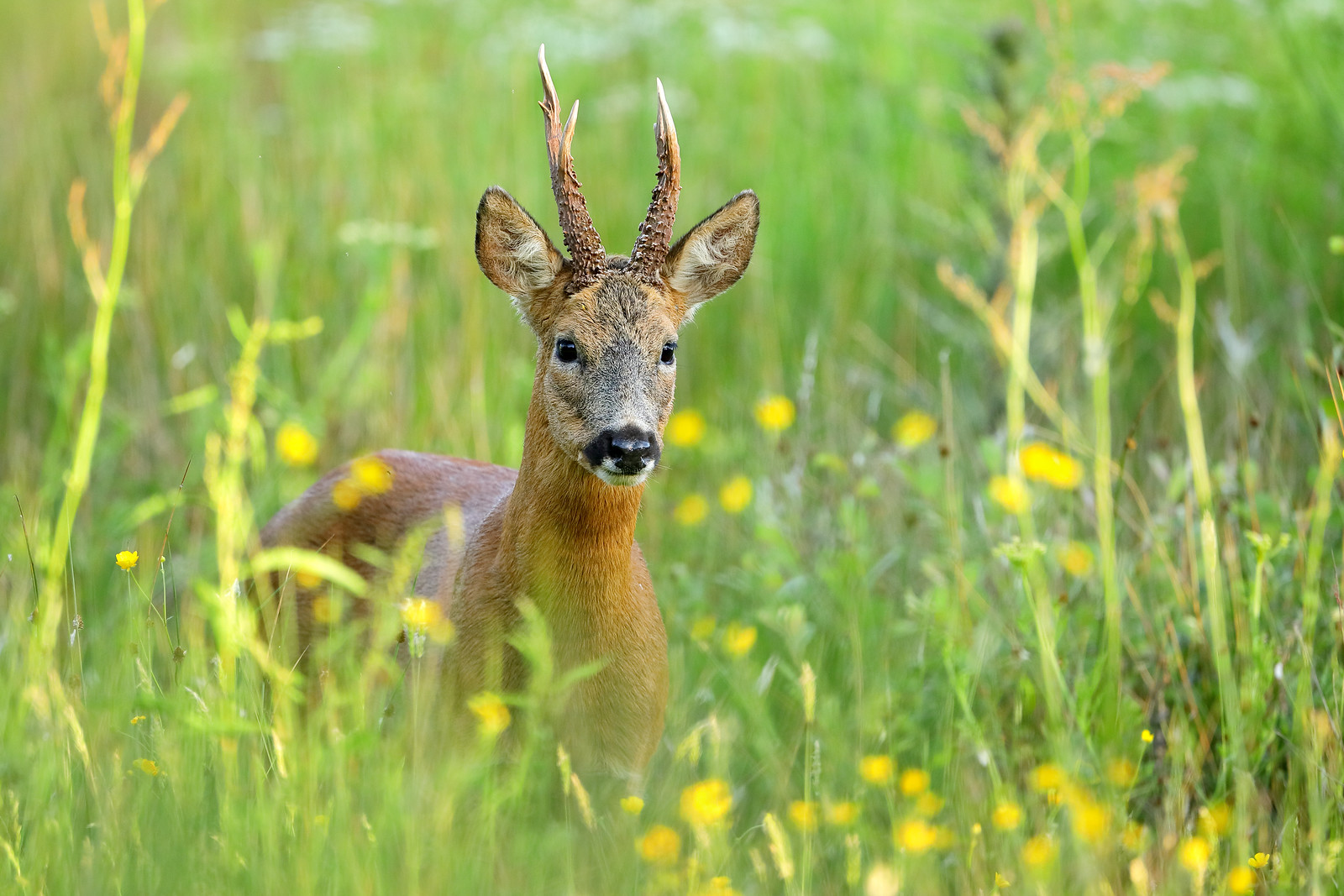
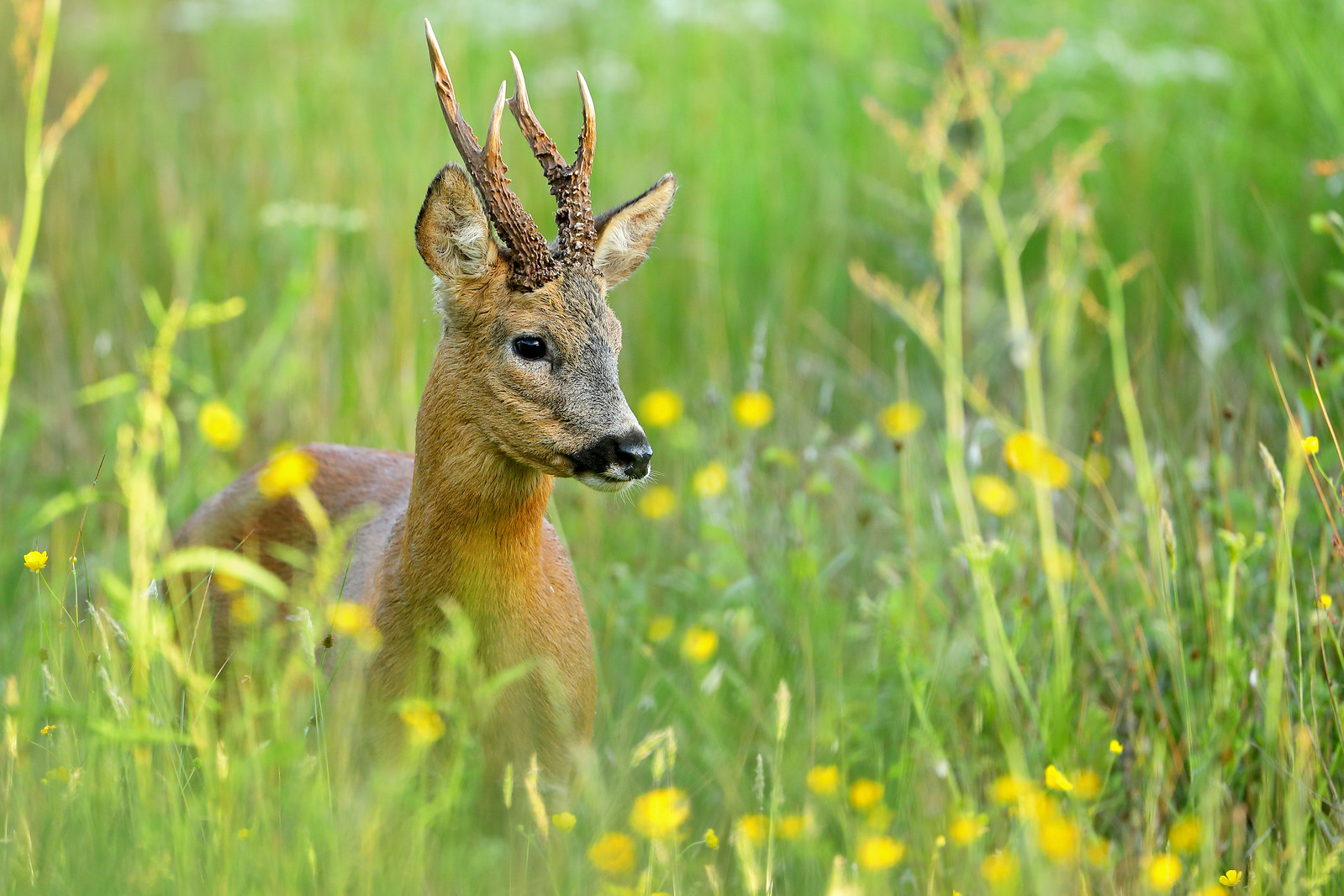

The mature buck appeared once again on Tuesday evening near to where I saw him on Monday. Although he spent about a minute staring into the camera, he became relaxed more quickly this time. Everyone loves images of roe looking directly at the camera, but this is not their natural behaviour. The next two images show him losing interest, as he looks to visit the buttercups to his left. Roe are drawn to this particular location, because of the flowers and its proximity to hide and observe places under trees. It pays to understand that roe have limited fat reserves to waste on escaping when they don't need to and they will accept quiet, predictable human observers. After 25 minutes, the deer became distracted by people nearby and shortly afterwards bolted across to the adjacent field when chased by a dog. When I asked the owner to keep his dog on a lead, he told me to 'f*ck off' and raised his middle finger.
On another day, I spotted the doe and her baby at 5pm in a field used frequently by dog walkers. As a partially blind mother and vulnerable baby, they were sitting ducks to some of the characters about and I feared for their safety. I could have taken advantage of a photo opportunity, but I instead semi-circled them to purposely usher the pair into a privately-owned field. My trick worked. The mother appeared, but had left the baby safely in a thick hedge. Hopefully, the pair will soon escape the attention of dogs, as the grass grows long enough to completely obscure them.
The unfortunate character responsible for suggesting procreation is not typical of the area. It's true that boredom attracted visitors, who would otherwise be attending various forms of purchased entertainment, but they've gone now. People here are quite down to earth, welcoming and considerate. Much more so than Brighton. I love visiting the nature reserve so much, that I may even consider moving up here when I'm older and make Roe deer a lifetime project. My experience of living in Brighton is another topic, but I don't feel comfortable using my camera in the city because of all the negative and hostile reactions from people.

The deer meadow is home to many wild flowers and plants. I found these mesmerising orchids, hidden within a large group of Dill plants. The orchids wouldn't have looked out of place in a fully-staffed garden. Unfortunately, sunny conditions and 28°C temperatures broke down as the heatwave ended. I photographed these orchids in rain, which became so heavy, I was forced to pack my camera away and conceive an alternative plan for getting home. This meant cycling in torrential rain through dark suburban roads, which were under several cm of water to the nearest railway station and changing for a service to Brighton. Not the way I wanted to end this year's adventures in the meadow, but according to the rainfall radar, the earliest time for the rain to clear was about 11pm.
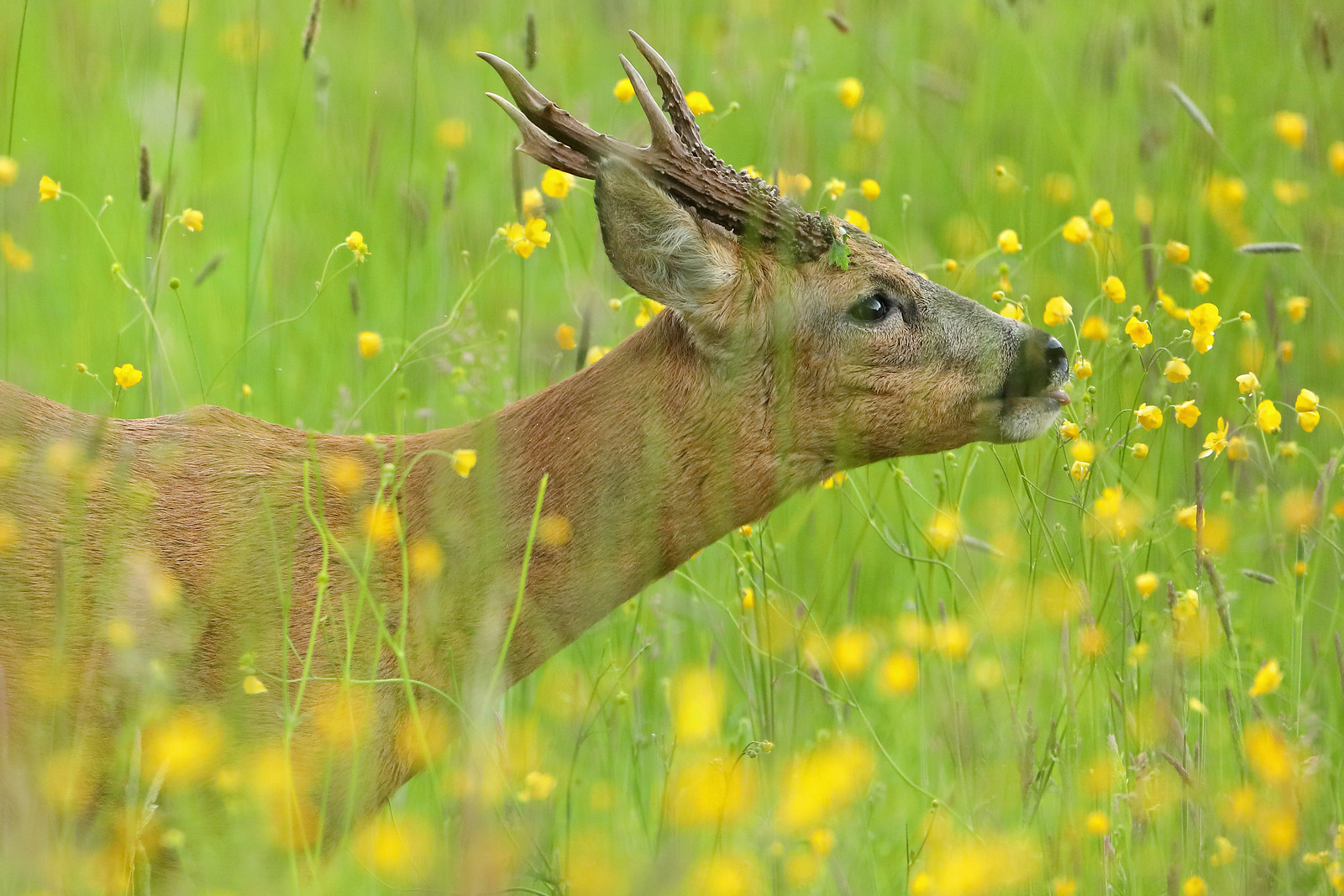
I hope you've enjoyed my early summer roe deer photos as much as I've enjoyed taking them. This is always the project I love the most and feel the saddest about having to stop. Traffic to this site is now very small due to tech giants skewing their algorithms towards credentialed, 'trustworthy' internet brands to the detriment of what they deem 'marginal content'. Ten years ago, the internet was briefly a much more open space to express ideas and attract engagement, where all traffic had equal priority, but this has changed, ostensibly to filter out 'fake news' and deliver 'relevant' content to people. I am currently verifying my site in the Google Search Console and Bing Webmaster Tools, submitting a sitemap and requesting page indexing to help people find my work, but I am not hopeful this will lead to increased traffic or meaningful interaction.
The one place my work still thrives is good old Flickr, which is a platform that makes an effort to treat each post equally. I have a strong following there and I don't feel that I'm being manipulated or algorithmed into oblivion because my content is not 'optimised'. In any case, if you do happen to like my photos, please add my site to your bookmarks and leave a comment.

















Comments
Roe can be difficult, but if you're lucky enough to find a site, where they are used to humans, it's relatively easy to stalk them in the open. The buck in my essay spent 25 minutes very close by and he could see me at all times. I never hide myself. If there's food available and the roe is territorial, one could spend all evening with them, if it wasn't for disruptive walkers.
I began missing the meadow not long after coming home. I have some holiday booked for early July, so I will be returning. Early in the week is best, as people stay away.
I could achieve so much more if I lived nearby. I once camped in a neighbouring field and saw the meadow at dawn. It looked quite alien in the mist and dew, as I'm used to seeing the evening sun shape the landscape.
I began my fascination with roe in 2003, after encountering a doe just outside Brighton. Her paradoxical mixture of fear and curiosity marked out this species as unusual. The way she ran off and came back even closer planted the idea, that they were capable of tolerating human company in the right circumstances.